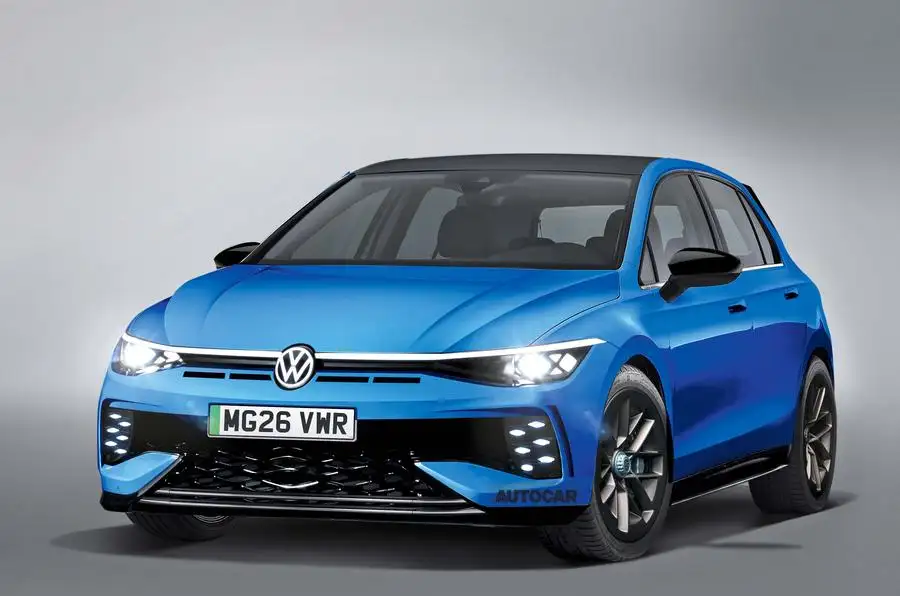Iconic model to continue alongside similar-size ID 3; GTI and R badges to continue into electric age.
The ninth-generation Volkswagen Golf will be electric-only and be the first VW produced on the new SSP architecture when it launches in 2028.
It’s shaping up to be the most radically reinvented iteration of the ever-popular family hatchback yet, which will also usher in a raft of new technology as part of an all-encompassing transformation plan for the VW brand.
Its arrival will follow an extensive mid-life overhaul to the current Mk8 Golf to sustain its popularity for another three to four years and meet the stricter Euro 7 emissions regulations that are provisionally set for July 2025.
This, Volkswagen boss Thomas Schäfer confirmed, will see the model through to its all-electric next generation, in which it will sit between the upcoming ID 2 and the VW ID 3.
When it does arrive, the Mk9 Golf will ride on the new SSP platform, which promises a step-change in terms of performance and utility over the current MEB architecture.
This means the electric Golf could be one of the most technologically advanced family hatchbacks on the market when it lands.
“The SSP architecture will balance the need for scale and standardisation with differentiation and speed,” Volkswagen Group CEO Oliver Blume said recently, touting a suite of technological advances that will mark out VW’s second-wave EVs from its first.
Chief among these upgrades will be the integration of 800V electrical architecture, which will allow for charging speeds far and above the 175kW maximum rate of the VW Group’s current EVs.
Cars based on SSP will be able to top up from 10-80% capacity in as little as 12 minutes, Volkswagen has said, compared with the 35 minutes of the latest MEB cars and quicker even than today’s fastest-charging road cars.
The platform and its associated ‘2.0’ software stack are also being designed to accommodate level-four autonomous driving functionality – which means any Golf model using these systems could allow for hands-off driving, where and when local laws permit.
This new platform was originally due for volume production in 2026 but has been beset by well-publicised development delays (which have forced sibling brand Audi to use a platform from SAIC for its next-generation Chinese-market EVs).
But of perhaps most importance, considering the Golf’s long-held position as one of the world’s best-selling cars, is that Volkswagen is prioritising affordability for its next generation of EVs. As a result, the ninth Golf is expected to be more comparable in price with its predecessor than the ID 3.
The VW Group’s new ‘Unified’ battery cells will be developed and produced in-house and shared across all EVs from all brands in order to shave production costs, and a much higher degree of component sharing across the board will boost economies of scale and again cut the cost of bringing each car to market.
With these systems in place, Blume has suggested, “most” SSP-based EVs can achieve profit-margin parity with the company’s combustion-engined cars, with development costs slashed by 30% compared with MEB-based cars, all of which means these next-generation EVs can be cheaper at the dealership.
Creating the all-important Mk9 Golf will be the top priority for recently appointed Volkswagen design boss Andreas Mindt, whose ID 2all concept, which was revealed mere weeks after he replaced Jozef Kaban in the role earlier this year, previewed a bold change in design direction for Volkswagen’s EVs.
Mindt said the approach is about “transferring the DNA of our icons into the future”.
He went on to identify three key pillars of the company’s future design ethos: stability, likeability and excitement. That tallies with Schäfer’s pledge to imbue an element of recognisability in future Volkswagens but without veering too far towards the retro ethos of the ID Buzz.
“The brand always has to reinvent itself and bring out new things,” he said. “When we bring a new version of something, it had better be a great interpretation with the newest features.”
As such, the ninth-generation Golf will be more of a design evolution than a revolution, in keeping with all previous generations over the past half-century.
It will, however, take the lead from the ID 2all concept by adding a host of new cues that nod to its radically different conception. Crucially, Schäfer added that by 2030, all of Volkswagen’s cars “will have buttons” as their primary interior controls.
The move is in line with his plan to bolster the usability of mass-market models by moving away from the often criticised touch controls of today’s ID cars.




